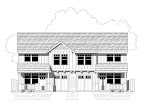Roof pitches are expressed in several ways depending on where you are building. Common in the United States is to use a number over 12. That is, for every 12 inches you go horizontally, a certain pitch will go up a certain number of inches. A 4/12 pitch roof goes up 4" for every foot it goes out. It's a rather shallow roof, easy to walk on but still sheds rain in all but the most of monsoons. It's not highly aesthetically pleasing though unless it utilizes 3' overhangs for a prairie style look. An 8/12 pitch roof CAN be walked on with the right shoes but also looks much better and can have livable attic space. This convention can be used for any number. A 16/12 roof is not unheard of. A 21/12 pitch roof will give you a nice equilateral triangle. Though most designers won't even think about it, it is perfectly acceptable to call out a 5.71/12 pitch roof if that would help make the roof plane 20' even instead of 20'-7.5".
In other countries where the X over 12 makes less sense due to the metric system, degrees of pitch can be used. This is almost simpler on one hand. But building it in the field requires a different skill set or tool. A high schooler might immediately understand a 30° pitch roof better than 7/12.
For your convenience here is a simple chart showing the comparison of roof pitches to angles:
| 1/12
|
4.76° |
| 2/12 | 9.46° |
| 3/12 | 14.04° |
| 4/12 | 18.42° |
| 5/12 | 22.62° |
| 6/12 | 26.57° |
| 7/12 | 30.26° |
| 8/12 | 33.69° |
| 9/12 | 36.87° |
| 10/12 | 39.81° |
| 11/12 | 42.51° |
| 12/12 | 45° |
| 14/12 | 49.40° |
| 16/12 | 53.13° |
| 18/12 | 56.31° |
| 21/12 | 60.26° |
| 24/12 | 63.43° |
| 27/12 | 66.04° |
| 30/12 | 68.20° |
| 45/12 | 75.07° |
Or you can use
this handy calculator.
Istockhouseplans strives to make the best use of your materials. If you would like us to analyze your plan and convert roof pitches to the most economical use of your lumber, please
contact us.






No comments:
Post a Comment